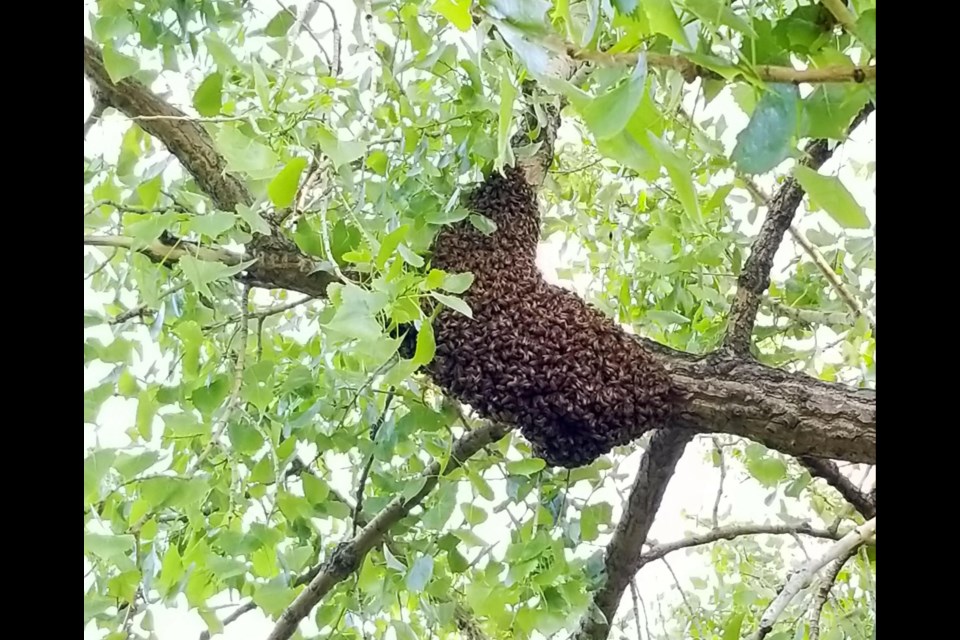With summer approaching, Longmont is still buzzing — with honey bees.
Spring brings wildflowers, tulips and the buzz of bees seeking out new homes. Finding a swarm of honey bees on a tree, fence, garage or part of your house can be quite unsettling. So what should you do when you find a swarm?
“First you should rejoice and do a little dance that there are still bees in the world,” said Tim Hod, owner of Longmont’s Highland Honey.
Colorado is home to more than 950 species of bees, according to the University of Colorado Boulder. Effects of climate change, pesticides and pollution, among other issues, have led to a decline in the populations of bees and other pollinators over the past 60 years. Between 1947 and 2008, honey bee populations dropped by 61%, according to data from the USDA.
Hod, who has worked with bees for almost 50 years, explained that swarming is a natural part of the evolutionary and reproductive process for bees. The hive splits off, leaving a new queen with the old hive. The old queen and half the hive will fly some distance away, usually a tree branch, and scout bees will start the search for a new hive location. Once a scout finds an ideal location, it will bring back other bees to confirm the location before relocating.
“Bees need a hollow space roughly the size of a five gallon bucket to maintain the ebb and flow of their hive,” Hod said. “When they get ready to relocate, they gorge on enough food to survive a few days out of the hive, which makes them quite slow and almost docile.”
“An open soffit on your house really is a perfect location for bees,” Hod said. “Maybe not for you, if it’s your house. People get nervous, but you don’t need to worry about trouble from honey bees. They don’t eat wood, you won’t get honey dripping down the walls. Still probably better for you and the bees to not move into your structure.”
Longmont resident Rachel Dessert found a swarm last week on one of the cottonwood trees on her property. After some searching online, Dessert called a few local beekeepers to see if someone could collect them.
“I knew they may try to build a hive in a less than desirable spot in a shed or house siding if we couldn’t offer them one,” Dessert said.
“If you see a swarm on your property, you should take a picture and then call a beekeeper,” Hod said. “Give them the location on your property, then pull up a chair and sip some lemonade because it’s really quite magical.”
Hod emphasized calling one beekeeper, or your local beekeeping swarm hotline, to minimize the chaos and confusion. Most beekeepers will collect a swarm free of charge, unless it involves removing a colony from inside a structure. Swarms rest in the early morning and near dusk, so those are the best times for a keeper to start the collection process.
“To shake the bees out of the tree, I’ll bring a small hive body with a few empty frames in it and some food for the bees,” Hod said. “Once you move the queen bee into the box, about 95% of the bees will follow. We’ll leave the box of bees near where the swarm was, so they can fan out their pheremones and tell their bee buddies where the new home is. We can usually get all the bees in by nightfall, giving them time to settle down before we relocate them. If you try to move the box too soon, those other foragers and scouts can get scared and maybe aggressive when they come back to a missing swarm.”
Dessert said a local keeper came by early the next morning, after she called in the swarm. By evening, all the bees were settled and taken to their new home.
“The whole experience was extremely exciting,” Dessert said. “It’s great to know we have amazing people like this dedicated to protecting our valuable and precious resource, the bees.”
“These last 20 years, with the amount of environmental damage in the world, it’s getting harder to keep bees,” Hod said. “Bees are a finite resource. People like Rachel are heroes for preserving this amazing natural resource and calling in experts to make sure it’s taken care of the right way. Be responsible humans, protect the bees.”
The Colorado Beekeepers Association has a swarm removal hotline, as well as a zip code based map to locate swarm catchers and beekeepers nearby.



